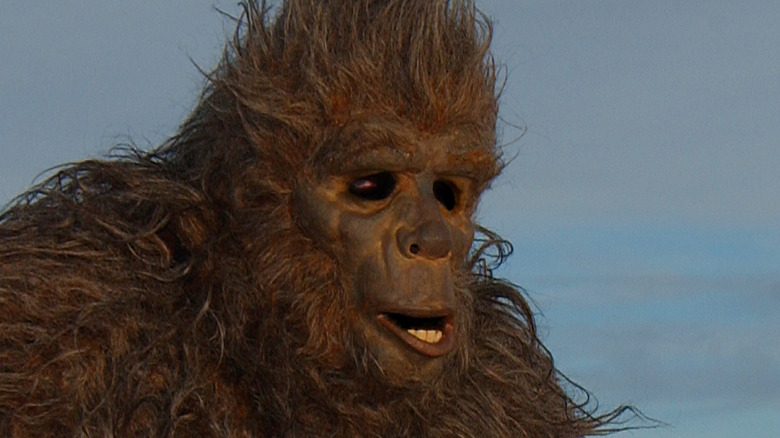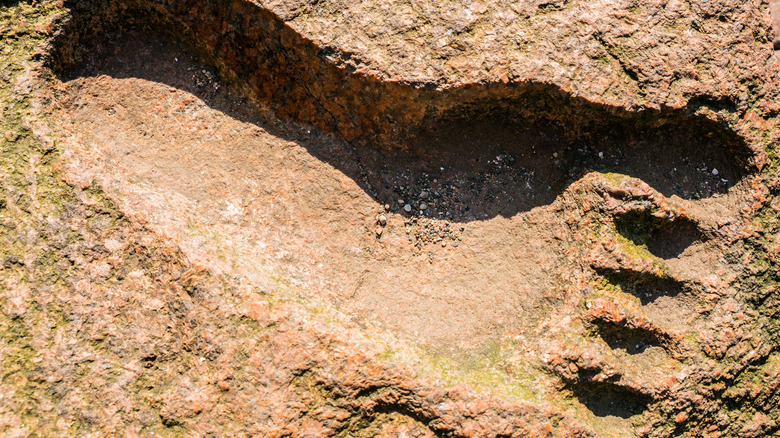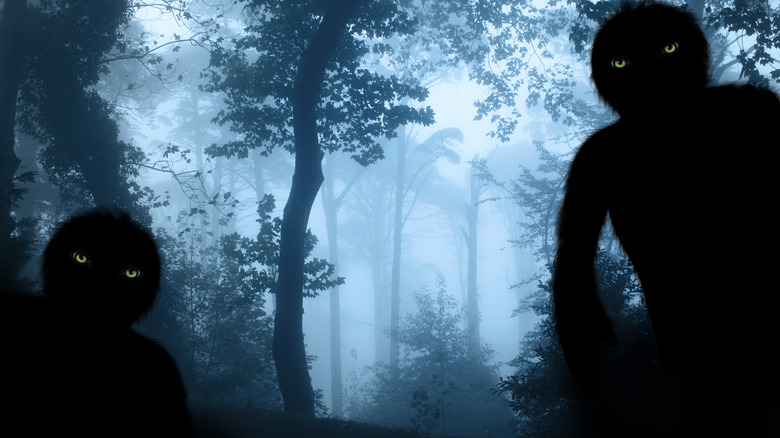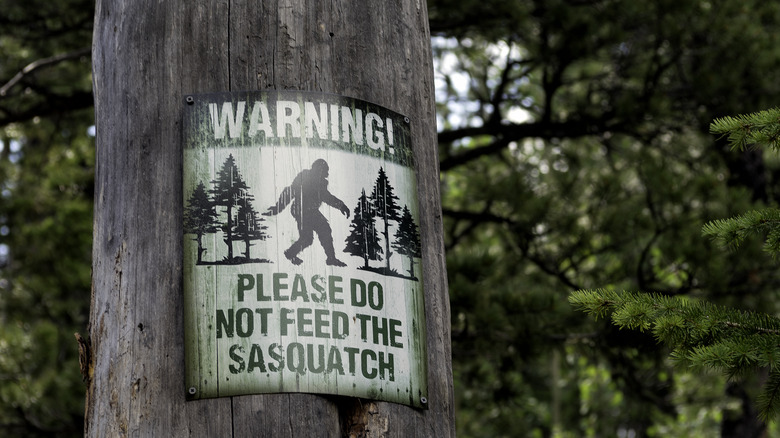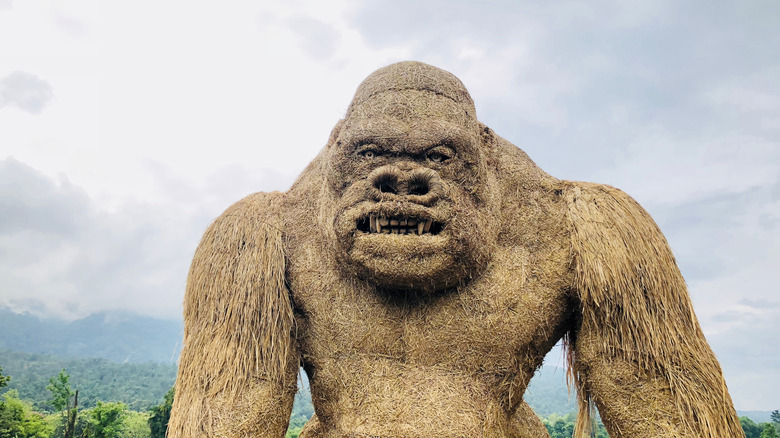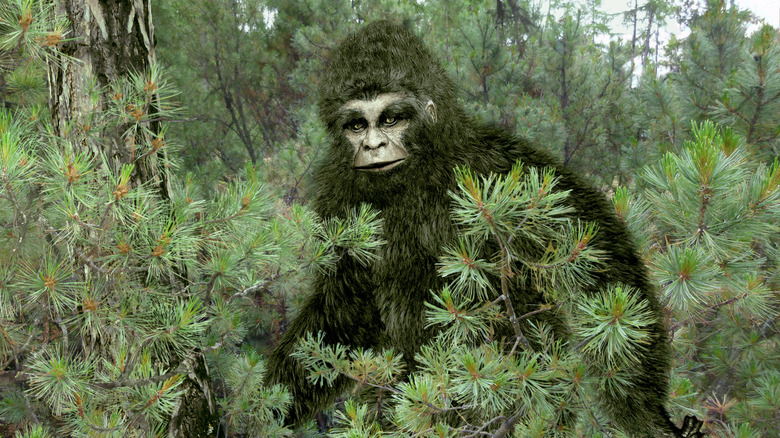The Biggest Bigfoot Theories
The lush forests of North America are said to be teeming with folkloric creatures, from lake monsters to mothmen to groundhogs with magical powers (via Mental Floss). While each legend and tall tale in the region has its share of supporters, no legend has endured quite like that of Bigfoot.
Bigfoot's tale, and also his footprint, for that matter, are larger than life for Pacific Northwest locals in particular (via Popular Mechanics). This goes for bikers, miners, and trappers, and for members of Indigenous tribes, the story dates back thousands of years.
Like the creature itself, historical depictions of Bigfoot have been, well, hairy. Some believe he was a bearlike man yowling through the forest, leaving massive footprints in the soil. In other traditional tellings, Bigfoot is a she, a giant brooding mother overly protective of her beastly children.
It's called by other names, like Sasquatch and Yowie. Is Bigfoot, animal, man, or myth, or something in between?
America's Indigenous tribes describe Bigfoot in various ways through both written and oral legends
According to Oregon Encyclopedia, the term Sasquatch, alternatively used for Bigfoot, is a play on the Halq'emeylem language's Sasq'ets, which is a term many of British Columbia's First Nation's Peoples used for Bigfoot. In the book "Sasquatch: Legend Meets Science," author Jeff Meldrum explains that at least 60 distinct Native American tribes believed in some version of Bigfoot, whom they described mostly as a "Wildman of the woods."
Popular Mechanics points out that Indigenous tribes often differed over whether the Bigfoot creature was meant to be loved or feared. For example, in the Kwakiutl tribe's legend, Sasquatch is a hairy mother with a heart of gold, roaring to protect her children from harm. Other legends, like those coming out of the Miwok tribe, have a much darker take on Bigfoot. Their oral traditions paint a barefoot half-man, who shares the characteristics and temperament of a wild bear. Bigfoot couldn't possibly be both these things — or could he? Some legends claim there is more than one Bigfoot (via Oregon Live), which would make multiple descriptions ironically accurate.
Woodsmen claim to have witnessed Bigfoot(s) for decades
As Europeans made their way to the hills of North America in search of gold and opportunity, some of them claim what they encountered instead was Bigfoot (via Popular Mechanics). Their tales of the towering creature were whispered through the woods and eventually printed in the newspapers of the time. Bangor Daily News reports that in 1886, multiple newspapers, including the Waterville Sentinel, published an account referring to a 10-foot-tall Wildman with apelike arms who crushed men to death in the forests of Maine.
Perhaps the most notorious report of that era took place in 1924. It involved Bigfoots (or Bigfeet, whichever word you'd rather use to describe multiple mythical creatures) encroached amid the trees. Oregon Live reports that this story first spread by way of gold prospectors, who claim to have encountered a whole crew of ape-men, 7 feet in stature and snarling, with a thirst for blood and a penchant for lobbing boulders at human beings. While the newspapers hastily printed titles claiming "Fabled Beasts Are Said To Have Bombarded Cabin," investigations led by the U.S. Forest Service yielded zero evidence for the claims.
Naturists and Evolutionists have tried to use Bigfoot to prove their theories
As time wore on and the Bigfoot legend endured, many naturists like Ivan T. Sanderson and evolutionists like Grover Krantz saw Sasquatch as a way to prove their theories (via Popular Mechanics). Their attempts to use Bigfoot to prove their theories was largely unsuccessful for a very good reason. In order to do this, they would first have to prove the existence of Bigfoot.
Describing Bigfoot as the real-life Abominable Snowman, as cryptozoologist Sanderson did in his 1961 book "Abominable Snowmen," did much to entertain the masses but little to impress academics. Evolutionary biologist William Straus called the collection of improbable evidence "anything but convincing."
Still, he had some staunch support from fellow cryptozoologist and evolutionary theory proponent Grover Krantz, who worked for decades as a professor of anthropology at Washington State University in Pullman. Krantz laid down his life and reputation all in the name of Bigfoot. According to Smithsonian Magazine, Krantz believed Bigfoot was the lost relative of the Gigantopithecus and a living link for evolutionary theories to progress. Like many before him who tried and failed, Krantz was unable to present Bigfoot's body to the scientific community. He did, however, donate his own, which is still currently on display at the National Museum of Natural History.
The now-extinct Gigantopithecus is the closest thing science has to Bigfoot
Millions of years ago, in the distant forests of Southeast Asia, a 10-foot-tall primate once lived. According to Live Science, he has been extinct so long that only the recovery of dental records alludes to his existence. It's important to point out that the gigantic creature wasn't an ape-man. He was just a really big ape. And he wasn't residing in North America, but many miles away, on the continent of Asia.
Even so, theorists love the idea of linking the huge toothy primate with the lore of legend. This is kind of sketchy, considering that even information about the Gigantopithecus itself is quite limited. When probed for clues on this extinct animal's appearance, Enrico Cappellini of the University of Copenhagen made the following conclusion: "the information we retrieved can't say anything about appearance, phenotype or biology. There's no evidence for that," he told Live Science. Without any information about the biology of the Gigantopithecus it would be difficult, bordering impossible, to prove it had any relation to Bigfoot.
The Patterson–Gimlin film is still the most widely-cited source of evidence for a real-life legend
People who hold steadfast to Bigfoot theories point to grainy footage taken 50 years ago as proof of the mythic beast (via OPB). The film, shot by rodeo stars with a 16 mm movie camera in 1967, depicts a hairy manlike figure stalking the banks of Northern California's Bluff Creek (posted on YouTube).
Skeptics point out the fact that the film coincides with the timing of the original "Planet of the Apes" film and the realistic ape costumes that were emerging as a result. However, Bigfoot enthusiast and professional researcher Cliff Barackman, who currently owns the largest collection of "Bigfoot prints" on record, says there's more in the foot than meets the eye.
"There are a few frames there where we see Patty take her heel off the ground but yet keep the entire forefoot in touch with the ground," he says, suggesting that this feature is unique to Bigfoot, and therefore proof of the creature's existence. Yet, even Gimlin the cameraman admits the footage is underwhelming, and paled in comparison to what he claims to have witnessed in person (via Popular Mechanics).
